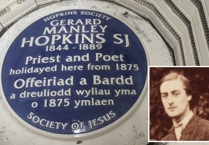Answers are being sought over the “missing” history of a once well-known Porthmadog ship, which may have played a “secret” role in Wartime Britain.
An appeal has gone out for help to “fill in the gaps” over what happened to the SS Florence Cooke – or ‘the Florrie‘ – as she was affectionately known – between May and October, 1944.
The ship carried explosives and munitions and was one of the few powered ships associated with the port of Porthmadog.
She is believed to have taken part in various special Wartime missions involved in D-Day, in June, 1944, according to Porthmadog Maritime Museum, – although not much is known about her role, according to museum volunteer and North Wales branch of the Merchant Navy Association chairman, Captain Dave Creamer.
Captain Creamer, from Penrhyndeudraeth, has been researching the vessel.
.jpg?width=752&height=500&crop=752:500)
His investigations came about amid a recent appeal to find North Wales Merchant Navy veterans who took part in Operation Neptune – also known as D-Day or the Normandy Landings.
The branch hopes to invite Merchant navy veterans who took part in D-Day - or their families - to a special service at Llandudno War Memorial on Sunday, 1 September.
Whilst researching North Wales ships and crew, Dave hit “a stumbling block” whilst looking into the history of the Florrie.
The ship belonged to England-based Cookes Explosives Ltd, which had a depot at Penrhyndeudraeth. The now de-commissioned explosive site there is known now as the Gwaith Powdwr nature reserve,
Owned by RT Cooke, Florrie was originally used to transport explosives and raw materials for mines and quarries, but later used to carry shells and ammunition.
Describing Porthmadog’s maritime past, the museum includes a small feature about this, has a file of photographs and newspaper articles, and historical information about the ship on its website.
It was registered in Sunderland, but was the last trader to claim Porthmadog as her home port.
The ship was built at Hepples yard in South Shields to the order of the Cookes Explosives.
“Their offices and distribution depot, from where explosives were sent to the surrounding coal mines, was at Maiden Law, Co Durham,” the website states.
“Increased demand for explosives during the First World War forced Cookes to look for a quiet site to build a new factory, and Penrhyndeudraeth, near Porthmadog, was chosen.
“Florrie started trading in 1923. Her cargoes were raw material to Porthmadog for the manufacture of the explosives, then the finished product was carried to the Tyne.
“She had a hinged mast and funnel which could be lowered to allow passage up the river to Newburn. Explosives were then taken by lorry to Cookes’ depot.
“Explosives and detonators were delivered to other ports in Cornwall and Scotland. The return cargo was usually household coal although she did sometimes wander further afield in the coastal trade.
“There was some passenger accommodation intended for company personnel, though the Captain could allow others to travel onboard.
“She was requisitioned by the Admiralty in 1939 and used as an ammunition ship, first at Milford Haven and later at Scapa Flow.
“She took part in the Normandy landings and was released from the Navy in 1945.
“The Florrie continued on the explosives run until 1959 when it was decided road transport was more efficient.
It added: “She was sold to a Dutch ship-breaker, though there is a tantalising story of her being seen, minus machinery and accommodation, in use as a dumb barge, trading on the inland waterways.”
Captain Creamer says details of what happened to her between May and October, 1944 are missing.
He researched archives in Caernarfon and Dolgellau, but was unable to find records of the ship between the period covering D-Day - 8 June, 1944.

He is appealing for anyone with information, for crew who may have served aboard the ship, or anyone who had family aboard with memories of the Florrie.
It is not known if records from that period are classified, possibly relating to the ship’s work during the war, or just missing or lost.
Captain Creamer says there are newspaper clippings linking the ship to D-Day Landings in the museum.
Operation Neptune was the largest seaborne invasion in history. It started with the liberation of France, and the rest of Western Europe, and laid the foundations for the Allied victory on the Western Front.
Captain Creamer said: “Lots of people in Porthmadog and beyond still have fond memories of the Florrie; she was a very well known ship in her heyday.
“But it would appear there is very little information if any in local records about her from May-October 1944, which is a puzzle.
“This may be because personnel were totally committed to the events occurring or because such information has been deemed ‘not for public eyes.'”
“I know the Florrie was deployed in the ‘Special Services’ group for D-Day but, interestingly, there is no mention of her in any of the books about ships involved in D-Day
“Newspaper cuttings in possession of the Porthmadog Maritime Museum indicate the Florrie was supplying ammunition to two naval monitors bombarding the French coast during the landings.
“I went to Caernarfon and Dolgellau archives. I spent an hour-and-a-half looking at the ship’s overtime records and chandlers orders, receipts and payments, the master’s accounts of wages, but everything stops in May, 1944 and doesn’t appear to resume until October, 1944.
“Either those records were never kept - which I can’t imagine - or they may have been locked away and won’t be released until an official period of time has passed. We just don’t know, we just hit a brick wall.
“A cutting in the museum places her there, as a special services ship. I think it is because she was a ‘special’ ship, because she was handling explosives, ammunition.
“It is very strange. We’d love to find out more. If anyone can help fill in the gaps or has memories of the ship, please get in touch!
“If anyone can help us trace her crew or their families, we’d like to invite them to our service of commemoration in September.”
The museum is always looking for volunteers. Anyone who can help should contact the museum.
.jpg?width=752&height=500&crop=752:500)
.jpg?width=752&height=500&crop=752:500)

.jpeg?width=209&height=140&crop=209:145,smart&quality=75)


Comments
This article has no comments yet. Be the first to leave a comment.